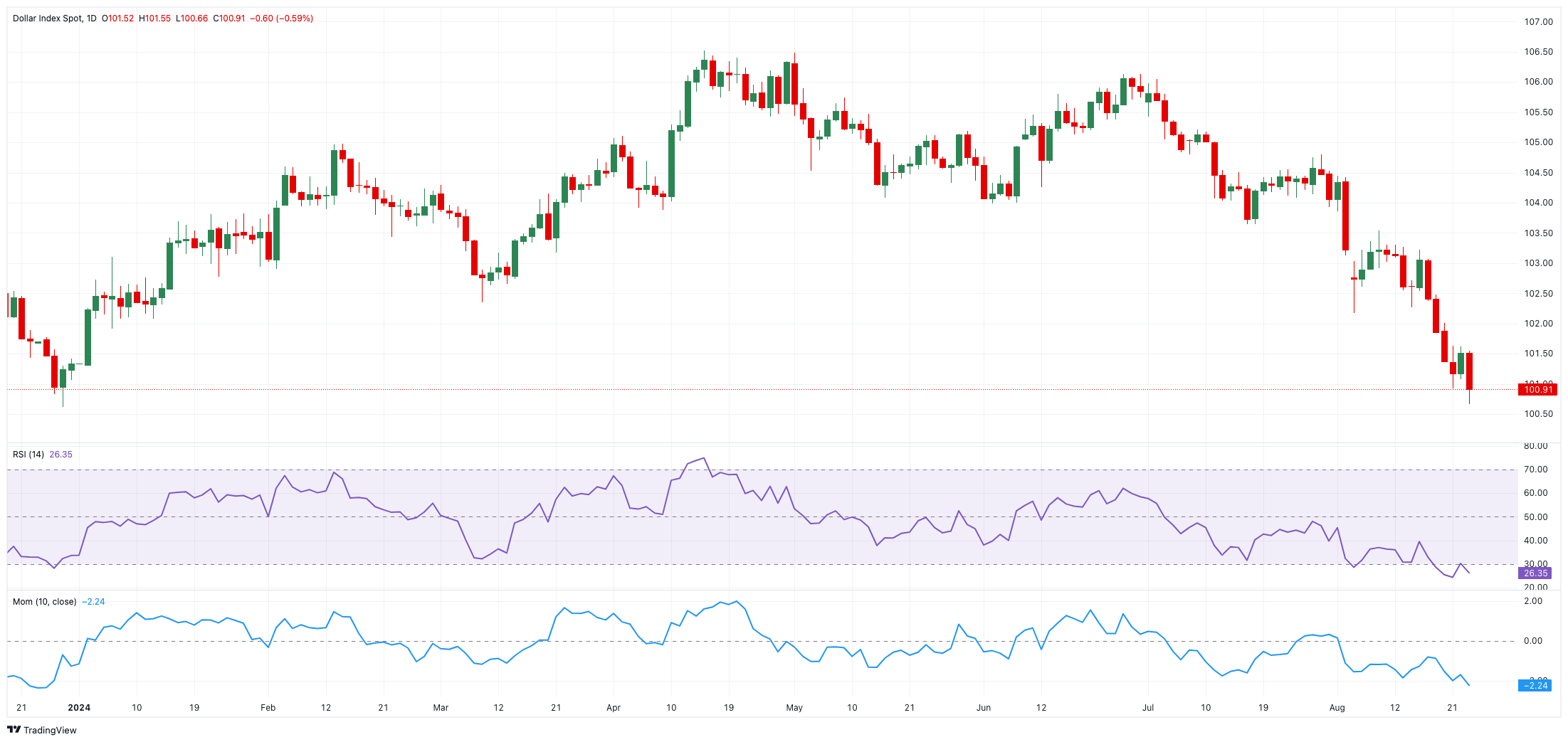- US Dollar Index (DXY) collapsed to 13-month lows near 100.60.
- Chair Powell favours an interest rate cut next month.
- Investors’ attention now shifts to the release of PCE inflation data.
Next significant support lines up at 100.00 threshold
Market participants continued to punish the Greenback so far this week, sending the US Dollar Index (DXY) to fresh 2024 lows in the vicinity of 100.60 as the week drew to a close.
Incessant selling pressure stemming from the rising likelihood of the start of the easing cycle by the Federal Reserve (Fed) in September kept the US Dollar on the back foot amidst an erratic performance of US yields, while some comments from the Fed’s rate-setters also contributed to the selling frenzy.
A rate cut in September is a cinch. The focus is now on the economy
Bets for an interest rate cut by the Fed next month have remained on the rise so far this week. This view also appeared to be in line with that of some Fed officials.
Indeed, Kansas City Fed Bank President Jeff Schmid, known as one of the more hawkish members of the bank, mentioned that he is closely monitoring the factors contributing to the rise in the Unemployment Rate and will base his decision on data to determine whether to support a rate cut next month.
His colleague, Boston Fed President Susan Collins, suggested that the Fed might soon be ready to initiate a rate-cutting cycle, indicating her potential support for a rate cut at the central bank's policy meeting next month.
Similarly, Philadelphia Fed President Patrick Harker expressed his willingness to back a rate cut in September, provided the data meets his expectations. Harker noted that, barring any unexpected shifts in the data, he believes it is time to begin the process of lowering rates.
Finally, Chair Jerome Powell’s perspective emerged at the Jackson Hole Symposium, where he expressed explicit support for interest rate cuts, stating that further cooling in the job market would be undesirable. He conveyed confidence that inflation was nearing the bank's 2% target.
Powell emphasized that the Fed did not seek or welcome additional softening in labour market conditions and assured the crowd that they would do everything possible to support a strong labour market while advancing toward price stability. He also indicated that with the right adjustment in policy restraint, there was good reason to believe the economy could return to 2% inflation while maintaining a robust labour market.
So far, the CME Group's FedWatch Tool sees a 65% chance of a 25 bps rate decrease in September, with 35% expecting a 50 bps cut.
All in all, if we steer away from the more than likely rate cut in September, investors are expected to start assessing the performance of the domestic economy. Despite earlier recession concerns appearing to have dissipated, upcoming data releases carry the potential to affect the monetary policy dial, particularly regarding the probable size of the imminent rate reduction.
What are the prospects regarding monetary policy overseas?
Meanwhile, the European Monetary Union (EMU), Japan, Switzerland and the United Kingdom are all facing increasing disinflationary pressures. In response, the European Central Bank (ECB) cut rates by 25 bps in June and maintained a dovish stance in July, with policymakers still uncertain about further rate cuts after the summer, despite investors already factoring in two additional cuts later in the year.
Similarly, the Swiss National Bank (SNB) unexpectedly reduced rates by 25 bps on June 20, while the Bank of England (BoE) lowered its policy rate by a quarter-point on August 1. In contrast, the Reserve Bank of Australia (RBA) took a more hawkish approach by holding rates steady at its August 6 meeting, with investors expecting the bank to start its easing cycle in the first quarter of 2025. On the other hand, the Bank of Japan (BoJ) surprised markets on July 31 by delivering a hawkish message and raising rates by 15 bps to 0.25%.
What about politics?
Since Kamala Harris became the Democratic Party's presidential candidate for the November elections, polls are now quite divided on the potential outcome. However, it is important to consider that another Trump administration, along with the possible reintroduction of tariffs, could disrupt or even reverse the current disinflationary trend in the US economy. This scenario might lead to a shortened Fed easing cycle as a result.
US yields lost momentum this week
The performance of US yields across the curve mirrored that of the US Dollar, heading south in the first half of the week. The pullback preceded a lacklustre recovery in the latter part of the week, always in response to swings in investors’ mood surrounding the most likely interest rate cut by the Fed next month.
Upcoming key events
Moving forward, all the attention is expected to be on the publication of the Fed’s preferred inflation gauge, the Personal Consumption Expenditures (PCE), on August 30. Despite the importance of the reading on the Fed's plan to cut rates, such a move should be well priced in by the time of the release. Secondly, the Conference Board will release the Consumer Confidence print on August 27.
Techs on the US Dollar Index
The odds for the continuation of the selling bias in DXY have increased since the index convincingly broke below the key 200-day SMA, today at 104.02.
If sellers maintain their control, the US Dollar Index (DXY) may first drop to the 2024 bottom of 100.66 (August 23), closely followed by the December 2023 low of 100.61 (December 28), and eventually test the psychological level of 100.00.
On the upside, there is immediate resistance at the weekly top of 103.54 (August 8), prior to the key 200-day SMA and the weekly peak of 104.79 (July 30). Should this area be trespassed, the DXY could advance toward the June high of 106.13 (June 26), before the 2024 top of 106.51 (April 16).
On the daily chart, the RSI remains in the oversold region around 27, opening the door to a potential bullish attempt in the very near future.
Economic Indicator
Personal Consumption Expenditures - Price Index (YoY)
The Personal Consumption Expenditures (PCE), released by the US Bureau of Economic Analysis on a monthly basis, measures the changes in the prices of goods and services purchased by consumers in the United States (US). The YoY reading compares prices in the reference month to a year earlier. Price changes may cause consumers to switch from buying one good to another and the PCE Deflator can account for such substitutions. This makes it the preferred measure of inflation for the Federal Reserve. Generally, a high reading is bullish for the US Dollar (USD), while a low reading is bearish.
Read more.Last release: Fri Jul 26, 2024 12:30
Frequency: Monthly
Actual: 2.5%
Consensus: 2.5%
Previous: 2.6%
Source: US Bureau of Economic Analysis
US Dollar PRICE Today
The table below shows the percentage change of US Dollar (USD) against listed major currencies today. US Dollar was the strongest against the Swiss Franc.
| USD | EUR | GBP | JPY | CAD | AUD | NZD | CHF | |
|---|---|---|---|---|---|---|---|---|
| USD | -0.53% | -0.71% | -1.00% | -0.73% | -1.09% | -1.40% | -0.05% | |
| EUR | 0.53% | -0.18% | -0.45% | -0.21% | -0.57% | -0.65% | 0.48% | |
| GBP | 0.71% | 0.18% | -0.29% | -0.03% | -0.38% | -0.45% | 0.43% | |
| JPY | 1.00% | 0.45% | 0.29% | 0.26% | -0.10% | -0.19% | 0.73% | |
| CAD | 0.73% | 0.21% | 0.03% | -0.26% | -0.37% | -0.43% | 0.45% | |
| AUD | 1.09% | 0.57% | 0.38% | 0.10% | 0.37% | -0.07% | 0.81% | |
| NZD | 1.40% | 0.65% | 0.45% | 0.19% | 0.43% | 0.07% | 0.88% | |
| CHF | 0.05% | -0.48% | -0.43% | -0.73% | -0.45% | -0.81% | -0.88% |
The heat map shows percentage changes of major currencies against each other. The base currency is picked from the left column, while the quote currency is picked from the top row. For example, if you pick the US Dollar from the left column and move along the horizontal line to the Japanese Yen, the percentage change displayed in the box will represent USD (base)/JPY (quote).
Information on these pages contains forward-looking statements that involve risks and uncertainties. Markets and instruments profiled on this page are for informational purposes only and should not in any way come across as a recommendation to buy or sell in these assets. You should do your own thorough research before making any investment decisions. FXStreet does not in any way guarantee that this information is free from mistakes, errors, or material misstatements. It also does not guarantee that this information is of a timely nature. Investing in Open Markets involves a great deal of risk, including the loss of all or a portion of your investment, as well as emotional distress. All risks, losses and costs associated with investing, including total loss of principal, are your responsibility. The views and opinions expressed in this article are those of the authors and do not necessarily reflect the official policy or position of FXStreet nor its advertisers. The author will not be held responsible for information that is found at the end of links posted on this page.
If not otherwise explicitly mentioned in the body of the article, at the time of writing, the author has no position in any stock mentioned in this article and no business relationship with any company mentioned. The author has not received compensation for writing this article, other than from FXStreet.
FXStreet and the author do not provide personalized recommendations. The author makes no representations as to the accuracy, completeness, or suitability of this information. FXStreet and the author will not be liable for any errors, omissions or any losses, injuries or damages arising from this information and its display or use. Errors and omissions excepted.
The author and FXStreet are not registered investment advisors and nothing in this article is intended to be investment advice.
Recommended Content
Editors’ Picks

AUD/USD: Extra gains need to clear 0.6400
AUD/USD rose for the third day in a row, approaching the key 0.6400 resistance on the back of the acute pullback in the US Dollar amid mounting recession concerns and global trade war fear.

EUR/USD: Powell and the NFP will put the rally to the test
EUR/USD gathered extra steam and advanced to multi-month peaks near 1.1150, although the move fizzled out somewhat as the NA session drew to a close on Thursday.

Gold looks offered near $3,100
Prices of Gold remain on the defensive on Thursday, hovering around the $3,100 region per troy ounce and retreating from earlier all-time peaks near the $3,170 level, all against the backdrop of investors' assessment of "Liberation Day".

Interoperability protocol hyperlane reveals airdrop details
The team behind interoperability protocol Hyperlane shared their upcoming token airdrop plans happening at the end of the month. The airdrop will occur on April 22, and users can check their eligibility to receive $HYPER tokens via a portal provided by the Hyperlane Foundation by April 13, the team shared in a press release with CoinDesk.

Trump’s “Liberation Day” tariffs on the way
United States (US) President Donald Trump’s self-styled “Liberation Day” has finally arrived. After four straight failures to kick off Donald Trump’s “day one” tariffs that were supposed to be implemented when President Trump assumed office 72 days ago, Trump’s team is slated to finally unveil a sweeping, lopsided package of “reciprocal” tariffs.

The Best brokers to trade EUR/USD
SPONSORED Discover the top brokers for trading EUR/USD in 2025. Our list features brokers with competitive spreads, fast execution, and powerful platforms. Whether you're a beginner or an expert, find the right partner to navigate the dynamic Forex market.
